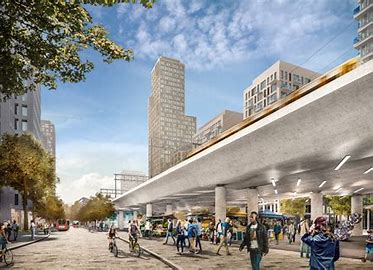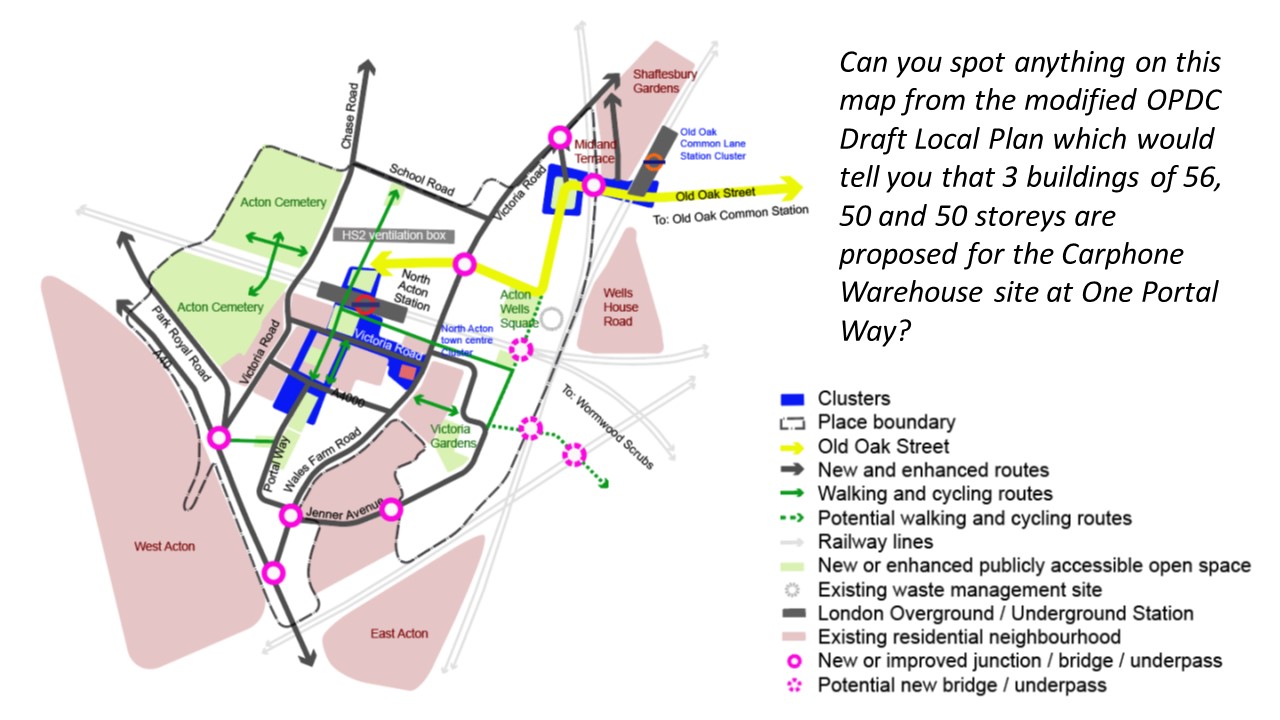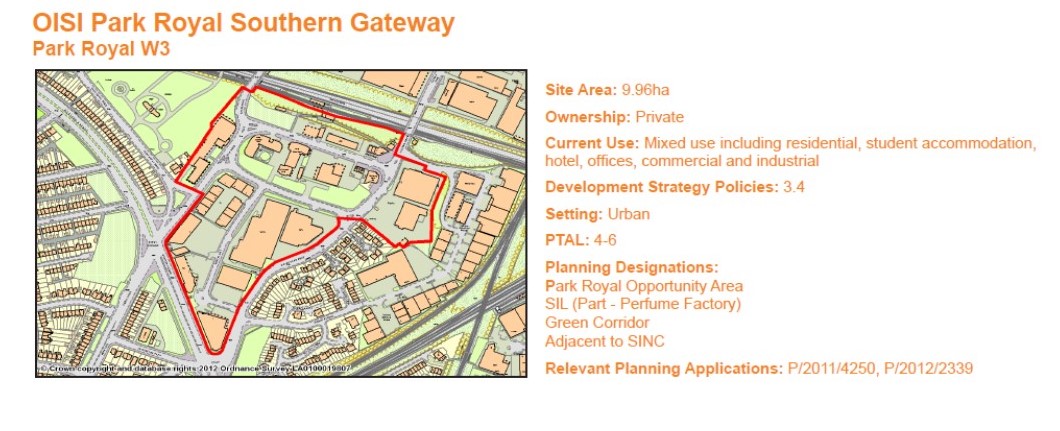The planning context for Imperial’s application at One Portal Way is unusual,
OPDC is one of two Mayoral Development Corporations in London (the other covering the former Olympic Park in east London). OPDC is governed by a Board that reports to the Mayor. This Board is made up of members appointed by the Mayor of London, plus the Council Leaders of Ealing, Hammersmith & Fulham and Brent. The Board is chaired by Liz Peace CBE.
OPDC acts as planning authority within its boundary (including North Acton). It is also a ‘delivery agency’ charged by the Mayor to deliver 25,000 new homes (and 13,000 of these by 2028).
As compared with other planning authorities in London (the 32 Boroughs and the City of London) the OPDC Board has less democratic accountability. The ability of local residents to lobby and exert influence on a planning decision is less than in the case of a local council..
For the past six years the OPDC has delegated (i.e. handed over) decisions on planning applications at North Acton to LB Ealing, for Ealing Council to decide. A series of planning consents for residential towers and student housing have been granted by Ealing, in the area around North Acton Station. The 45 storey development of One West Point was approved by Ealing’s Planning Committee, with a further 10 storeys consented in February 2020.
After a long period of discussions between Imperial, planning officers at Eailing, the OPDC, and the Greater London Authority, the OPDC decided in October 2021 to retain (rather than delegate) the decision on Imperial’s application. Ealing Council was not happy with this decision but OPDC as planning authority has this right to choose how applications are decided.
The proposed development at One Portal Way
- OPDC are the planning authority, but after 6 years since the Corporation took over planning powers for parts of Ealing. Hammersmith and Brent, the OPDC Draft Local Plan for the area remains under ‘examination’ by Planning Inspector Paul Clark.
- The OPDC Draft Plan was submitted to the Planning Inspectorate back in 2018. But OPDC has had to make extensive ‘modifications’ after Cargiant abandoned its proposals for 6,000 homes at ‘Old Oak Park’. Cargiant’s major regeneration project had formed the cornerstone of the first phase of the OPDC Draft Local Plan.
- Now in 2022, as an ‘emerging’ Local Plan, OPDC policies for North Acton and for Tall Buildings would normally carry significant ‘weight’ in a decision on the Imperial application. But following a hearing on January 11th 2022, the Inspector has asked for more work to be done by OPDC in explaining its policies on Tall Buildings, in order to achieve conformity with the 2021 London Plan.
- The new London Plan came into force in March 2021. Policy D9 on Tall Buildings is new and was strengthened from a different 2016 version following intervention by former Secretary of State Robert Jenrick in December 2020.
- Until the OPDC Local Plan is adopted, the Ealing Local Plan has continuing (but diminishing) weight in decisions on planning applications (see below)..
The above image shows what Cargiant planned for ‘Old Oak Park’. A new Overground station added to the West London Line at Hythe Road would have provided connectivity with the HS2 and Crossrail lines at Old Oak Common Lane station (due to open between 2029 and 2033).
Without this Overground, and with a proposed second ‘potential station’ at Old Old Common Lane unfunded and unlikely to be built, the Old Oak and StQW neighbourhood forums have argued that the OPDC Draft Local Plan has lost coherence as a spatial plan for a part of London due ultimately to include 25,000 new homes.
North Acton
The loss of the housing sites on the Cargiant land, as a result of ‘interim findings’ by Planning Inspector Paul Clark in September 2018, forced OPDC to search for alternative housing sites.
Housing targets for North Acton in Years 0-10 of the Draft Plan were increased from 3,200 to 5,250 via a ‘modification’ to the Draft Plan (i.e. after the documents were submitted to the Planning Inspector and during the course of his examination). An assumed 702 new housing units at One Portal Way forms a large part of this extra total at North Acton/Acton Wells ‘Place’ in the Draft Plan..
Public consultation on modifications to the September 2018 verision of the Draft Local plan took place in summer 2021. The consultation leaflet distributed by OPDC stated While the majority of the draft Local Plan will stay the same, our proposed updates identify some new sites for housing development and protect others for employment intensification.
The page of the consultation leaflet which explained ‘site specific’ changes included those at Old Oak North, Scrubs Lane, and Channel Gate. But not for North Acton.
The new London Plan Policy D9 includes a ‘Part B’ which states:
B1. Boroughs should determine if there are locations where tall buildings may be an appropriate form of development, subject to meeting the other requirements of the Plan. This process should include engagement with neighbouring boroughs that may be affected by tall building developments in identified locations.
B2. Any such locations and appropriate tall building heights should be identified on maps in Development Plans.
B3. Tall buildings should only be developed in locations that are identified as suitable in Development Plans.
This is one of the main grounds for an objection to Imperial’s application. The current (emerging) version of the OPDC Draft Local Plan does not conform with London Plan Policy D9. It may do, by the time the Draft Plan is adopted. But as of now the Imperial application is ‘premature’ in relation to the OPDC Draft Local Plan.
Ealing Council’s earlier decisions at North Acton and LB Ealing policy for North Acton
The planning consents at North Acton granted by Ealing’s Planning Committee (in behalf of OPDC) have relied heavily on a site allocation policy in the 2013 Ealing Development Sites DPD. This document dates back to 2013. It includes a site allocation and policy guidance for an area OIS1 Park Royal Southern Gateway, which is how North Acton was described at the time.
This planning guidance for North Acton states The site is considered in principle an appropriate location for tall buildings, however the acceptability of tall buildings will be determined based on the detailed design as presented in a full planning application; outline planning applications for a tall building will not be considered. If tall buildings are proposed they must be attractive as viewed from all angles, contribute to an interesting skyline, and create a well-defined public realm at street level with active ground floor frontages and a high quality landscaping treatment that contributes to an improved public realm.
This Ealing Development Sites DPD does not identify specific locations for tall buildings at North Acton. Nor does it identify ‘appropriate heights’. Buildings of 56 storeys would not have been contemplated back in 2013. Were OPDC to rely primarility on Ealing development plan documents in making a decision on the application, the Ealing Core Strategy and Develoopment Sires DPD also fail to conform with new London Plan Policy D9.
The Ealing DPD also states outline planning applications for a tall building will not be considered. This may be one of the reasons for the late switch from LBE to OPDC, as the planning authority deciding the Imperial application.
The danger of an outline consent for four further buildings in Imperial’s proposals is that this first set of decisions set the ‘planning parameters’ for the second phase. Massing, height and floorspace would all be fixed from then on, with Imperial needing only to return when ready with further applications on ‘reserved matters’.
Pre-application advice from the GLA to Imperial College
As is usual for major developments, Imperial entered into a Planning Performance Agreement to obtain pre-application advice on its proposals. In this case there was one PPA with LBE Ealing and one with with OPDC. Imperial also used the pre-application advice provided by GLA planning officers.
After two requests from the Old Oak Neighbourhood Forum, copies of this pre-application advice were added to the OPDC planning file. They should have been published in the first place, under the terms of OPDC’s Statement of Community Involvement. Links to the three GLA documents are below:
The second of the above is the one that covers the issue of building height in the most detail, at paragraphs 42-50. Paragraph 43 offers some encouragement to those opposed to the building heights at Portal Way, in saying It is evident that considerable thought has been given to the layout and design of buildings to achieve good quality and well-connected public realm, however in terms of the built form relationship with nearby tall buildings of similar height, GLA are not yet convinced that three buildings that are greater than 50 storeys in height on the site are appropriate when considered against the current and emerging context. It should also be noted that all the buildings currently proposed in the scheme are tall buildings by definition, and the requirements of London Plan Policy D9 will therefore be rigorously applied to all the buildings in the scheme..
These three sets of pre-application advice were issued at a stage when planning officers at GLA, OPDC, and LB Ealing were all expecting the application to be decided by Ealing’s Planning Committee. This committee has a track record of granting planning consents to tall buildings in the face of concerted local opposition.
The application is now to be decided by OPDC’s Planning Committee. This committee has also gone along with officer recommendations to approve tall buildings (of 20-30 storeys) at Oaklands Rise and at four sites along Scrubs Lane. The committee has yet to refuse such an application. The committee has yet to decide an application on any proposals approaching 50 storeys and above.
The Imperial application will be referred to the Mayor at Stages 1 and 2, given its proposed heights. Will GLA officers prove in practice to rigorously apply London Plan Policy D9 to all buildings in the scheme?
In terms of governance arrangements, OPDC’s Planning Committee is made up of
- a Chair who is also a member of the OPDC Board (William Hill)
- three independent members
- four local councillors, who have been recommended by the three boroughs whose boundaries falls within the OPDC area.
In thr past, this has led to some close votes when those members who are local councillors have listened to the views of their constituents. But even in the event of a split 4/4 vote the Chair has a casting vote. Imperial College has a seat on the OPDC Board, not that this Board member will play a direct part in deciding the planning application.
As and when the date of a Planning Committee meeting is fixed, to decide this application and an officer report and recommendation appears online, we will update this web page accordingly.



